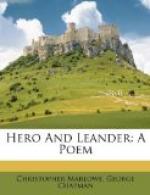|
This section contains 6,738 words (approx. 23 pages at 300 words per page) |

|
SOURCE: Collins, S. Ann. “Sundrie Shapes, Committing Headdie Ryots, Incest, Rapes: Functions of Myth in Determining Narrative and Tone in Marlowe's Hero and Leander.” Mosaic IV, no. 1 (fall 1970): 107-22.
In the following essay, Collins maintains that the mythological episodes of Hero and Leander function “both as indicators of the poem's tone and as emblematic parallels of segments of the narrative.”
Hero and Leander, the unfinished epic which was almost solely responsible for Christopher Marlowe's reputation as a poet among his contemporaries, has frequently proved at worst blinding and at best enigmatic to modern critics. Like Hero, “Moving severall ways / At one self instant,” they have found it to be variously a tragic epic of love pure as the driven snow (admittedly a minority view of days past, chiefly held by C. F. Tucker Brooke), a cynical dumb show of Bergsonian comic types, a banquet of poetic sense, an...
|
This section contains 6,738 words (approx. 23 pages at 300 words per page) |

|


